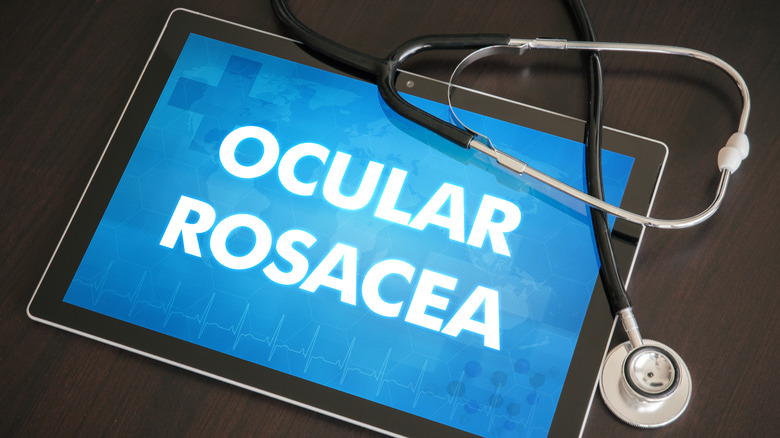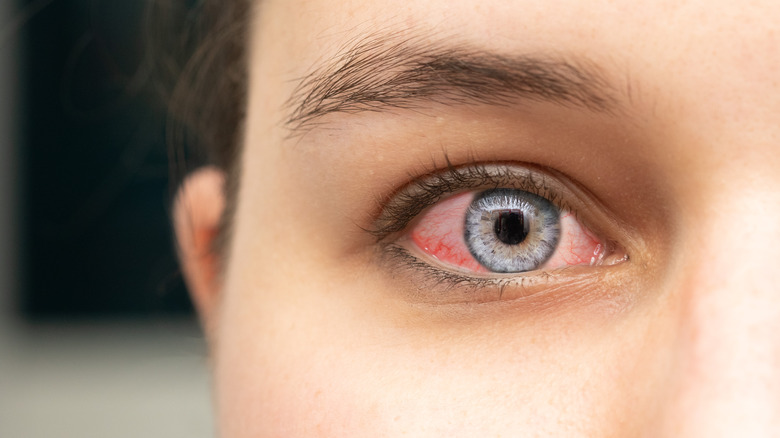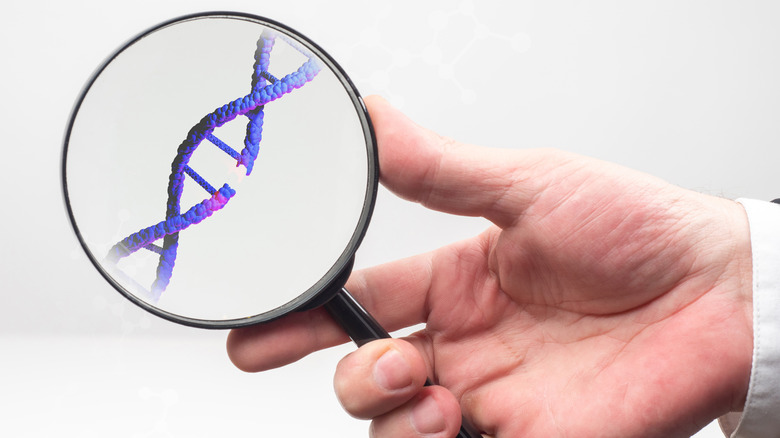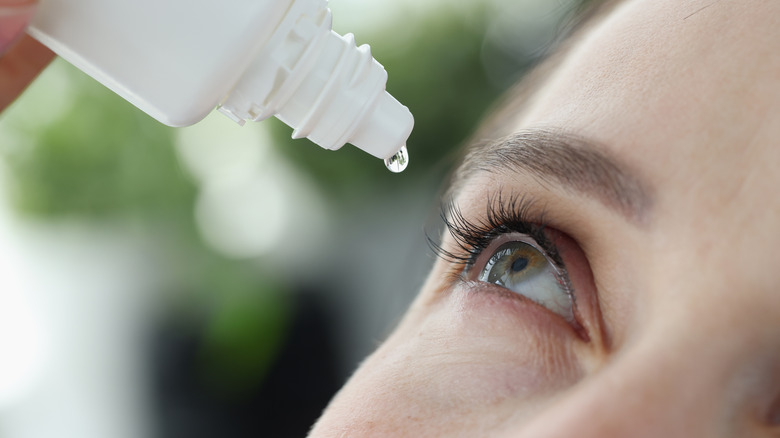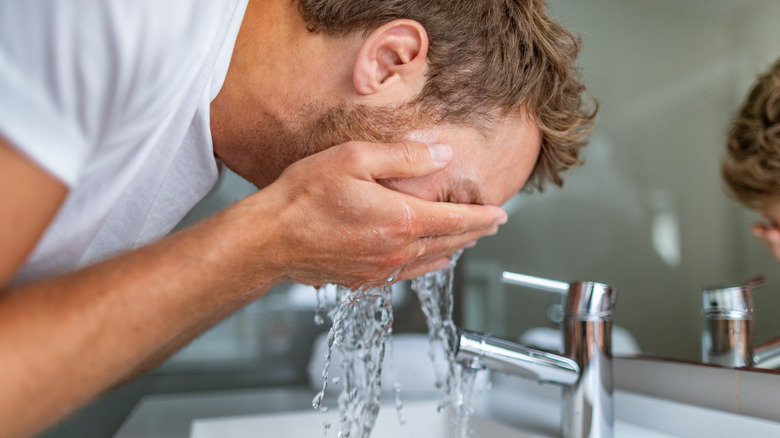Everything You Need To Know About Ocular Rosacea
The American Academy of Ophthalmology explains that rosacea is a chronic skin condition that causes your face to redden. Sometimes people will have what looks like acne as well. When it specifically affects the eyes, it is called ocular rosacea.
They state that some people will have rosacea on their skin only. Others might have ocular rosacea, but none on their skin. Yet others will have both.
Women are more likely to have rosacea than men. However, when men get it, it tends to be more severe, says the National Institute of Arthritis and Musculoskeletal and Skin Diseases (NIAMS). In addition, men are as likely as women to have ocular rosacea specifically, per Mayo Clinic.
According to the Mayo Clinic, rosacea tends to mainly occur in people between 30 and 50 years old. People with light skin who blush easily seem to be most prone to this condition. NIAMS concedes, however, that it might be underdiagnosed in people with darker skin because it may be masked by the skin's pigmentation.
Signs and symptoms of ocular rosacea
The Mayo Clinic states that people with ocular rosacea may have red, itchy, burning, or watery eyes. Their eyes may feel dry or gritty as well. Additionally, they may experience sensitivity to light or blurred vision. Their eyelids may appear swollen and red, and the eyes themselves may be bloodshot. People with this condition may also experience recurrent eye or eyelid infections like sties, blepharitis, chalazia, or pink eye. NIAMS further notes that if ocular rosacea is not treated it can potentially lead to damage to the eye or vision loss.
In addition to ocular rosacea symptoms, a person with this condition might have symptoms of rosacea on their skin, according to NIAMS. They might have redness of the face that starts as temporary blushing, but may last for longer amounts of time as the condition progresses. Sometimes they might feel tingling or burning sensations along with the redness. Their skin might become scaly and rough. They might also develop reddened areas that turn into a rash that looks similar to acne. Blood vessels may become visible on their skin, appearing as thin, red lines on the nose and cheeks. Their nose might also take on a bulbous appearance as the skin thickens. This symptom is more common in men.
What causes ocular rosacea
No one knows for sure what causes rosacea, says the Cleveland Clinic. One possible explanation is that it's a genetic disorder that you inherit from either one or both of your parents. People with rosacea are four times more likely to have relatives who also have the condition, notes Medline Plus.
Another theory is that it's caused by the Helicobacter pylori bacteria, which is also known to cause stomach ulcers, stomach cancer, and gastritis. A 2018 study published in the journal BMC Infectious Diseases appears to confirm this link.
Medical News Today writes that it might also be due to abnormally-functioning facial blood vessels, although it is uncertain what is causing them to become inflamed.
The American Academy of Dermatology (AAD) discusses that environmental irritants can be triggers for rosacea. They cite sunlight and hairspray as being common triggers. Stress, heat, spicy foods, and alcohol can also set off symptoms.
How ocular rosacea is diagnosed
If you have the symptoms of rosacea, it's a good idea to visit a dermatologist, says AAD. A dermatologist is a doctor who specializes in conditions that affect the skin, hair, and nails. They are experts in diagnosing and treating diseases of the skin like rosacea. If you have ocular rosacea, you might also need to visit an opthalmologist, a doctor who deals with eye diseases.
There are no specific tests that can be used to diagnose ocular rosacea, explains the Mayo Clinic. Instead, your doctor will look at your skin and eyes to see if you have the telltale signs. Your doctor will also ask you questions about your symptoms and your medical history.
AAD further notes that, while there is no test that can be used to diagnose rosacea, your doctor may want to do tests that rule out other medical conditions that may have similar symptoms. Illnesses like an allergic reaction or lupus, for example, can manifest with similar symptoms.
Ocular rosacea treatments
The Cleveland Clinic explains that there is not yet a cure for ocular rosacea. Treatment at this point in time is mainly about avoiding its triggers and managing symptoms.
However, the Mayo Clinic says that certain antibiotic medications may be prescribed on a temporary basis, including tetracycline, doxycycline, erythromycin, and minocycline. Healthline states that oral antibiotics, rather than topical ones, are generally given for ocular rosacea. They can work within about six weeks, they write, but low-dose antibiotics might be prescribed for longer periods.
According to the American Academy of Ophthalmology, steroid eye drops are another option that might be used on a short-term basis to treat ocular rosacea, as they can reduce the redness and inflammation associated with a flare-up. Medical News Today says that long-term use is not recommended since it could cause glaucoma and cataracts. They further note that if topical steroids don't work, your doctor might prescribe topical cyclosporin.
Self-help for ocular rosacea
According to the Mayo Clinic, a good eye care routine is an important part of managing ocular rosacea. They suggest following your routine even after your symptoms disappear in order to prevent future flares.
They write that you should gently wash your eyelids twice daily using warm water or whatever product your doctor recommends for this purpose. The Cleveland Clinic suggests using a pH-balanced cleanser rather than soap.
If you wear makeup, the Mayo Clinic advises that it should be noncomedogenic and fragrance-free. They say to avoid makeup altogether if your eyes are currently inflamed. It is also recommended that you don't wear contact lenses if you are going through a flare-up, particularly if your eyes are dry.
They suggest avoiding things that precipitate a flare-up for you. Not everyone will have the same triggers, they write, so it's important to record your own personal rosacea triggers until you figure out what they are (per AAD). Additionally, Mayo Clinic says to avoid things that cause blood vessels in the face to dilate, such as drinking alcohol or eating spicy foods.
Finally, they say that if you need help with dry eyes, you can use artificial tears.

